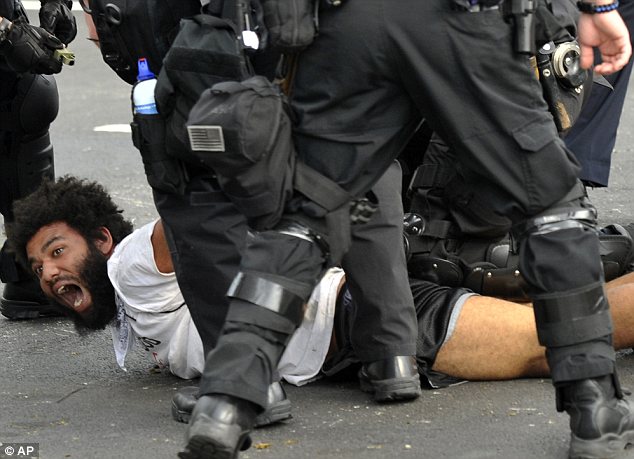NATO Summit Protests – Chicago 2012 Special Report
New in Ceasefire, Special Reports - Posted on Sunday, May 27, 2012 23:54 - 3 Comments
By Ashok Kumar
A protester is detained by police at a march and rally during this weekend’s NATO summit. (photo: AP/Washington Post)
Last weekend (19th-20th May) the city of Chicago played host to a summit of the North Atlantic Treaty Organisation (NATO). As predicted, protesters descended in numbers to voice their opposition to the summit being held in the city, as well as to NATO’s actions, present and past.
The immense chasm between what happened at these protests on the ground and the images displayed on both the mainstream media (CNN, BBC etc) or the mainstream social media (Facebook, Twitter etc) remains inexplicable and baffling to someone, like myself, who had experienced the event in real time.
It seems rather simple: you go out into the streets, march, there’s plenty of push and shove, and then you come home. Opening your computer, or turning on the TV, the same protest somehow takes an entirely different significance; magnified, amplified and menacing.
Facebook friends talk of protesters dying in the streets of Chicago, and shrill news anchors excitedly report “news” of masked “outside” agitators bent on destruction and anarchy. A protester pushing a police officer is no longer an isolated incident – it is now generalised into ‘three days of riots’.
Most present agreed that police outnumbered protesters by several thousand. The City under Rahm Emmanuel had spent over $50m for a weekend of military equipment and police overtime, whilst somehow slashing teachers salaries and privatising schools under the banner of absolutely necessary cuts and utterly unavoidable budgetary woes.
The counter-summit protests began on Friday the 18th, with the raucous rally of the National Nurses United at Daly Plaza with Rage Against the Machine’s Tom Morello. On Saturday Mental Health Movement activists and Occupy Chicago protestors upped-the-ante by targeting former Obama chief of staff-turned-Chicago-Mayor Emmanuel’s home.
On Saturday night roving bands of protesters ran through the city creating noise, no less than a mile away from where the conference was being held at the McCormick Center. On Sunday, the big protest day, there were 10 thousand protestors who marched down Michigan Avenue starting at “the Loop” and ending 2miles south.
The Chicago protests were expected to be much larger of course, but Obama and friends knowing that the anti-war movement is at its weakest in years chose to move the G8 to the ‘intimate’ setting of Camp David whilst keeping the NATO summit in Chicago, making it very hard for mass action to coalesce around both events.
Still, this state of affairs does have the merit of bringing up deeper questions about the purpose of protesting these massive gatherings of the WTO, IMF, WB, FTAA, NATO, RNC, DNC, G8, G20 and so on and on.
The NATO protests felt overwhelming, with rows of police armed to the teeth on all four sides and, for good measure, from above. As we marched down Michigan Avenue I had to ask myself ‘what do we accomplish when we have ever-declining numbers of protesters at each counter-event?”
It felt as if we were going through the motions, like tired actors, all playing our parts for an audience expecting the unexpected. A kind of Village People ensemble: the shirtless white-crusty, the masked anarchist, the aging hippie holding up a peace sign for the cameras.
It is this expectation, and this disconnect, that leaves us open to the caricatures. Since Seattle 1999, the left have imagined each successive protest as ‘the next Seattle’. What made Seattle – Seattle, was that it was the first of its kind, it was unexpected.
Others argue that building up protests to major events leaves behind an institution of resistance and local organising. Seattle 1999 helped develop a number of initiatives, notably Indymedia, but there is little evidence to support this claim. If anything, counter-summit protests since then have left the movement with little more than years of legal battles.
With this in mind, it’s important to let our collective opposition to these atrocious supranational institutions known through protest, but we are in urgent need of serious reassessment of our methods. As with Occupy, what the Chicago NATO protests show is that when faced with a downturn in struggle, new and dynamic means of opposition must be explored.
3 Comments
NATO protests – eyewitness report : AntiCapitalists
Ali
Totally on point. We need to rethink our strategies.
NATO Summit Protests – Chicago 201 : AntiCapitalists
[…] This article was originally published at Ceasefire magazine […]




[…] This article has been cross-posted with thanks from Ceasefire […]